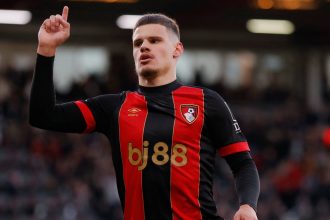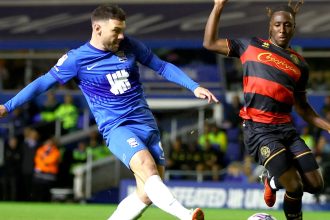The Herons' Round 1 playoff exit raises questions about their transfer and recruitment strategy over the past season
When Inter Miami crashed out of the 2024 playoffs Saturday night, it felt as if the American soccer community had come to a standstill.
That's how American sports goes, though. It's the playoff format, it's the excitement of a Cinderella story in a major tournament, like Atlanta United had accomplished. It's the storyline audiences typically crave, whether it be in College sports, the NFL, NBA, NHL, MLB, WNBA, etc. No matter the sport, the narrative follows.
What becomes more noticeable than anything, though, is the response. How does a team like Miami respond to an embarrassing and stunning defeat in Round 1 of the playoffs? Well, it needs to start with a hard look internally, and specifically, at their transfer strategy and roster assembly.
brought in 10 players to strengthen their 2024 title push, but only four started in their elimination game. Arguably, only three – Luis Suarez, Federico Redondo, and Julian Gressel – found any real success, each excelling at different points in the season. Others such as Matias Rojas and Marcelo Weigandt all played big roles during the campaign, but never found their footing with the club on a consistent basis.
Only one of those 10, Gressel, had previous MLS experience, and others like Yannick Bright and Leo Afonso – MLS SuperDraft picks – were thrown into the mix with no professional experience prior. Miami's transfer strategy ignored a key component of finding success in this league: embracing it.
Whether that be through the recruitment of league veterans or trading for intra-league talent to bolster the roster, MLS teams have always found success by relying on the individuals who have figured that out. Miami's 2024 downfall began when they ignored that crucial part of being a member of the league.
GOAL examines what went wrong with the team's transfer strategy in 2024 and how they can avoid repeating the same mistakes next season.
Get the MLS Season Pass today!Stream games nowGetty Images SportAcquisitions gone wrong: injuries to misfits
After missing out on the playoffs in 2023, Inter Miami's first acquisition ahead of the 2024 season was Suarez – and we all know how that's gone. He was stellar in 2024, and was nominated for both MLS Newcomer of the Year and MLS MVP, scoring 20 goals and recording nine assists. Signing a one-year deal, he was the perfect forward to bring in on a short-term deal to elevate their attack.
Things went downhill from there, even with relative success from others.
Gressell – a two-time MLS Cup winner – was their marquee offseason inter-league addition, but he was misused throughout the entire campaign. Playing a multitude of positions from the attack to the defense, by the time the end of the season arrived, coach Tata Martino had axed him from his XI and throughout the playoffs he went as an unused substitute, in a baffling turn of events.
Redondo, meanwhile, was their big purchase. They spent a club-record fee of reportedly $8 million to bring in the son of former Real Madrid and AC Milan star, Fernando, from Argentine side Argentinos Juniors to be the centerfold of their midfield. Unfortunately, it didn't really work the way they intended. He made just 16 appearances due to injuries and international commitments with Argentina U23s. He also picked up five yellow cards along the way, too. During his time on the pitch, he looked youthful and reckless more often than not, while lacking identity on the pitch.
Elsewhere, SuperDraft picks Leo Afonso and Bright both had impact on the pitch, but both dealt with injuries. Afonso made 11 appearances before undergoing Sports Hernia surgery in August, not taking the pitch during the remainder of the campaign, while Bright made 23 appearances, 14 of which were starts, but missed their crucial Game 3 in the postseason with a knock himself.
Other first-team contributors such as Marcelo Weigandt, who they signed on a season-long loan deal from Boca Juniors, proved to be a liability for the club. He was a weak point defensively that was constantly exploited. The right back never truly adapted to MLS and often found himself outclassed by opposition, despite making 23 appearances. Another, Matias Rojas, arrived to MLS with a bang, scoring five goals in his first six appearances with the club across all competitions, but then just bagged one in his next seven. He became a viable bench option, but never truly elevated the squad's standards.
Two of their most important signings, defenders Nicolas Freire and Hector Martinez, had their flaws, too. Freire was one of the defensive reinforcements they brought in to bolster their back line ahead of the campaign, however, the Argentine tore his ACL in May, resulting in him missing the remainder of the season. Martinez, meanwhile, arrived in August making seven total appearances for the Herons. Come the postseason, though, his performance in Game 3 was one to forget, with all three two of Atlanta's goals coming off of him missing his marks in the box.
Miami attempted to make moves, for certain. However, their stubborn strategy to strictly look at foreign talent with no MLS experience proved to be a downfall. For Martino, somebody who had already won an MLS Cup with Atlanta United, he should know better in terms of strategizing on how to build a roster with superstar talent in the attack.
In fact, there was even a blueprint for it ready for him in 2018 – and seemingly, he followed it. The 2011 LA Galaxy laid it all out on a plate for them.
AdvertisementGetty Images SportBruce Arena's blueprint
In 2011, the Galaxy won MLS Cup with a roster featuring the likes of David Beckham, Landon Donovan, Robbie Keane and Gregg Berhalter – while MLS' most-winningest coach ever, Bruce Arena, was on the touchline. Objectively, it was a star-studded team. However, it wasn't their stars that got them to MLS Cup. Rather, it was the creation of a complete squad, utilizing all the resources around them within MLS to succeed.
A pair of 2009 MLS SuperDraft picks in A.J. DeLaGarza and Omar Gonzalez locked down their defense, while the addition of defender Todd Dunivant in the same season built the core of their defense. Dunivant, an an experienced MLS defender at the time, arrived with two MLS Cups already in his back pocket – including one he had won with the Galaxy in 2005 during a brief first stint with the club.
Both Gonzalez and Dunivant made the MLS Best XI during the regular season alongside Donovan and Beckham on that roster. Meanwhile, the rest of their squad was built around supporting and getting the most out of their attack. MLS veterans Mike Magee, Sean Franklin and Josh Saunders rounded out the roster, while 2011 All-Star Juninho joined Keane in the field along with former MLS journeyman Adam Cristman in the final.
What made LA successful that season, after a six-season slump between their MLS Cup victories, was they looked within the league, used the assets that American soccer provided and used them to establish a roster built around their superstars. Arena's magic on the touchline didn't go unnoticed, either, but their brilliance truly arrived due to the creation of a perfectly balanced roster. Individuals who knew the league the challenges that came with it paired with some expensive superstars to light up the pitch.
They did everything right, and a lot of teams now look to that group as a perfect example of how to succeed in MLS.
Getty Images SportWhy didn't Tata look back?
What is surprising about Miami's roster in 2024, is how different it is from Martino's championship-winning roster with Atlanta in 2018.
That year, Martino took Atlanta to MLS Cup that certainly had stars, too, such as Josef Martinez and Miguel Almiron. Almiron is still MLS' most-expensive export transfer, at a staggering $27M when Premier League side Newcastle United purchased him in 2019. Martinez, meanwhile, was the quickest player to ever score 100 goals in the league.
What made that Atlanta squad special, though, was the people surrounding them.
Brad Guzan, hero of Atlanta's 2024 postseason triumph over was in net, while MLS veterans Michael Parkhurst, Greg Garza and Jeff Larentowicz helped anchor their back line. The most important part of the puzzle, though, was Darlington Nagbe. The former U.S. international and current Columbus Crew star was the key to their success all season long in the middle of the pitch.
Ahead of the 2018 season, Martino and Atlanta had paid a monumental fee, by intra MLS moves standard, of $1.05 million to the Portland Timbers, bringing him to the Eastern Conference club. Nagbe's arrival was flashy, too.
Club owner Arthur Blank flew him out in his own private jet, and he was given a red carpet treatment as he arrived.
The pulled out all the bells and whistles to bring a proven winner, an MLS veteran and a dominant force in American soccer to their squad. And it paid off, immediately. Martino looked internally within the league and asked "who can I bring in to win us a title?"
The answer was Nagbe.
While Martino isn’t the sole decision-maker for Miami’s roster as he relies on his front office to build the roster, it raises the question of why aporting sirector Chris Henderson and his team didn’t lean more into that strategy this season.
GettyNo margin for error….
A lot of Miami's strategy was to build around Messi and find players who fit his style of play. And any team would do the same for a player who has won Ballon D'Ors. So it wasn't a surprise when the team recruited his former Barcelona teammates, Suarez, Jordi Alba and Sergio Busquets. And that core of players, for the most part, didn't disappoint.
They claimed the regular season title lifting the 2024 MLS Supporters' Shield, set the league points record, qualified for the 2025 FIFA Club World Cup and broke barriers in viewership with matches, garnering worldwide audiences and creating a unique brand centered on the greatest player the game has ever seen. That itself is ridiculously impressive, and should be both appreciated and acknowledged.
Yet, as good as those accomplishments were, similar to Beckham's time in MLS as a player, without a title will feel less significant. And the time is ticking on Miami to bring one home as Messi's current contract ends in at the conclusion of next season. So what's next?
Miami is set to compete in the Club World Cup, have qualified for the CONCACAF Champions Cup and will look to win Messi his first MLS Cup. Falling short of all three would prove to be disastrous for a team of Miami's caliber and star appeal, so over the next few months, they will look to build a squad that can compete at the level of the competition.
Whether or not they look internally within MLS is an open question, but there are a handful of free agents that are out-of-contract such as U.S. internationals Aaron Long and Jackson Yueill and MLS veterans Ilie Sanchez and Joao Paulo that could all elevate their squad. All four have experience in finals on either the international or club stage. Determining if they fit the structure of the club would be the next step, but those are four examples of players that could have a Nagbe-type effect on the team.
Regardless of the path that the choose, there are blueprints they can follow. There are examples of how to build an MLS Cup-winning caliber squad around a handful of superstars on the pitch.
One thing is certain, though. Miami can't afford to repeat their 2024 postseason blunder next year, or they risk the Messi experiment being a failure.






